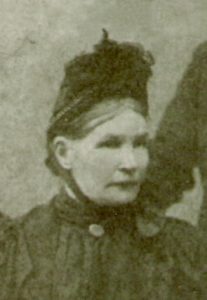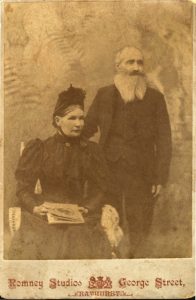8 minute read
Susannah Lawson was my 4 x great grandmother on my grandmother Irene’s side of the family. Susannah is another one of my ‘favourite’ ancestors, reasons being that a hold a photograph of her and she lived in the same town as me, Bathurst. I have been to her gravesite a few times. Susannah also sprang to mind recently when I was thinking about what story to write for a Mother’s Day release, particularly in light of the current debates around women’s reproductive rights in the U.S. You see Susannah birthed 13 children in her lifetime. Quite an extraordinary feat by modern standards yet not uncommon for her time, the mid-19th century. I think about her life and how she had so few choices when it came to control over her own body. She spent her whole life in service to others. Firstly her parents, then in domestic service and finally dedicating her life to raising her children and grandchildren. This is Susannah’s story.

Susannah’s life started in the grips of a family crisis. She was born around 1839 in Blacktown in Sydney’s west, to James and Maria Core, who by that time had been married for 19 years. Susannah had two older sisters, Margaret and Eliza and three older brothers, James, George and William. Two more sisters, Ann and Jane would arrive after Susannah. The family had initially lived at Parramatta but moved onto Blacktown after James’s run-ins with the law. All four of Susannah’s grandparents were convicts and their criminal ways did not abate once transported to Sydney. James Core followed in his parent’s footsteps and was transported to Newcastle Penal Settlement for pig stealing, in the years immediately prior to marrying Maria Bolton. James’s father had taught him farming as well but in order to supplement his income, James produced and sold sly grog, which was illegal in the colony. The police were regularly at the Core family home and James had a reputation for dishonesty. Times had been especially tough due to an ongoing drought and this was James’ way of making ends meet. You can read more about James’ farming hardships here: https://quirkycharacters.com.au/stories/drought-dust-and-despair-history-repeats-itself/
The Core children were taught from a young age how to interact with the customers and how to lie to the police to avoid being implicated. One incident recorded by the police in 1841 mentioned Eliza, aged about 7, selling rum to customers. Older sister Margaret testified that Eliza had brought out caps (bonnets) for the customer and not rum. However the magistrate was not one to be fooled so easily and convicted Maria for a breach of the Licensing Act and fined her 30 pounds, an enormous sum for the time. Maria could not pay the fine so she was placed into Campbelltown gaol for a period of three months. By now heavily pregnant, a petition by W.R Kenny, Surgeon, was conveyed to the magistrate and clemency was granted and Maria was released in time to give birth to her next baby. It is not known if little Susannah, aged just 2 years old, was taken to gaol with her mother, but as she is not mentioned in the police record, it is more likely her 15-year-old sister Margaret would have helped look after her younger siblings.
I’ve no doubt that as she grew older Susannah also helped out in the ‘family business’. There are no further criminal records for the family but of course this does not mean they didn’t just get better at hiding their activities. Alcohol and alcoholism was particularly rife in colonial NSW so we must understand that the Cores were not alone in pursuing extra money-making activities. But the consuming of and selling of alcohol would continue to impact the family negatively in the years to come. It had already killed Susannah’s grandfather, who had been murdered in a drunken bar brawl.
In an effort to re-start their lives Susannah’s parents moved the family to Penrith and by the early 1850s they were leasehold tenant farmers on the Lambridge Estate. Susannah’s childhood did not include schooling of any kind, indicated by the fact she signed her name on official documents in later life with a x. Susannah would have started her work life early, employed as a domestic servant, as many young girls were, for which there was no need for literacy. Then on the 16th May 1855, Susannah gave birth to a baby boy she named John Frederick. She was 16 years old. The father was named on the baptism record as George Small, labourer. I’m not sure it has been established exactly who George Small was, however other family historians seem to suggest that the ex-Mangles convict George Small, a man who would have been at least 30 years Susannah’s senior, was the father of her baby. That being the case, a significant power imbalance was at play. As far as I can tell, Susannah kept the child with her and soon after she and the rest of the Core family moved to Wattle Flat, near Bathurst. It was here that Susannah met another older man, George Lawson. He had married in 1854 but been widowed the following year, just a few months after Susannah’s son was born. His first wife likely died in childbirth. George and Susannah were married with the permission of her father in June 1856. She was just 17 years old and George was about 35 years old. At this time in NSW, there was still a much smaller amount of women than men so men were frequently older than their wives, often young women who had emigrated freely to NSW to work as domestic servants.
Over the next 25 years of her marriage to George, Susannah would give birth to 12 more children. The year after the marriage, 1857, Susannah’s first daughter Maria Jane, named after her own mother, who acted as the nurse and midwife, was born. My 3 x great grandmother Mary was born in 1859. George followed in 1861 and James in 1863. Then three more daughters, Susannah in 1865, Ann in 1867 and Sarah in 1869. A son William was born in 1872 but sadly died the following year, the only child Susannah lost out of the 13 she birthed. Then another three daughters were born, Emma in 1874, Martha in 1876 and Ada in 1878. Finally, a son named John Henry was born in 1881, completing the Lawson family. Susannah was now 42 years old.
George made his living as a gold miner, one man amongst the thousands who had left city areas and sought their fortune in pursuit of the precious metal. He was a prominent member of the small Wattle Flat community and clearly kept his family well from his mining enterprises. By the early 1880s, George and Susannah not only had some of their own children still in infancy, but they had also taken on their grandson George Brody, whose mother Mary, their second child, had left the young boy in their charge after his father had died. Susannah’s sister Eliza lived nearby with her French husband. The close-knit sisters were also in the early days of helping to care for their other sister Jane’s children. Jane’s life had ended in May 1878 from typhoid fever, claiming not only her but two of her children. Then Susannah lost her mother Maria in September the same year. Just when Susannah thought life had thrown them some hard times, the year 1880 was about to turn her world well and truly upside down.
Jane’s husband Joseph Poulson had been left to care for his remaining four children but he missed his wife desperately. A long-used tonic in the Core family was alcohol and again it was administered in the family’s dark times, this time to Joseph, to help quell his pain. But Joseph took to the liquor, mainly brandy, without restraint and was soon experiencing delirium tremens or ‘the horrors’. Then one awful night in March 1880, Joseph stood over two of his children, 12 year old Mary and 9 year old James with an adze (a half axe/half hammer tool) and brought it down on their heads and bodies with full force. They died instantly. Only half realising what he had done, Joseph went a neighbour’s house to inform him that something terrible had happened. No doubt both Susannah and Eliza and their husbands were also informed within hours and took the remaining infant son, 2 year old George, who was unharmed, into their care. It is not known who cared for George long term, however it is likely either Eliza or Susannah stepped in to bring him up. The murdered children were buried by their two uncles and the family and the small community of Wattle Flat were forever traumatised.
It is unfortunate in all this that we do not hear Susannah’s voice through the historical record. It is only in carefully chronically her timeline and life events that we can come to know something of her. What we can say of her though, was that despite her difficult childhood and the harsh times she lived in, she was able to nurture her children and give them all a better life. Although Susannah lived in one of the harshest winter environments in Australia with temperatures frequently plummeting to below zero, she managed to keep almost all of her children safe and indeed, they thrived. Her lived experience was confined to the demands of her family and she did this successfully.
The first decade of the 20th century had brought a steadiness to the Lawson family. Susannah and George had moved to Kelso, a suburb of Bathurst and they were surrounded by their children and numerous grandchildren. Around the time of her 60th birthday, Susannah and George posed for a portrait at a local Bathurst photography studio. Susannah looks serene and petite, seated next to George, her husband of fifty years. But Susannah was ailing by this time, after years of alcohol abuse which had left her in bad health. She passed away in February 1908, after a battle with cirrhosis of the liver and valvular disease of the heart. She was 68 years old. George followed four years later and together they are buried in Kelso cemetery, up on a hillside. Happy Mother’s Day Susannah.


